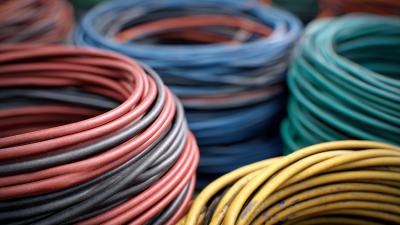
-
Home
-
Products
-
PVC Cable Material
-
Low Smoke Zero Halogen Cable Material
-
Cable material
-
Optical fiber cable
-
-
About Us
-
VR
-
News
-
Blog
-
Contact Us
Leave Your Message

The telecommunications industry is undergoing a transformative shift, driven by the ongoing demand for faster, more reliable internet connectivity. One of the key innovations facilitating this evolution is the use of Glass Yarn for Optical Cables. According to a report by Markets and Markets, the global optical fiber market is projected to reach $54.4 billion by 2026, with a significant portion attributed to advancements in optical cable technologies. Glass Yarn, known for its lightweight, strength, and thermal resistance, enhances the performance and durability of optical cables, positioning it as a pivotal material in the deployment of next-generation networks. As the need for high-speed data transmission grows, driven by trends like 5G and IoT, the integration of Glass Yarn in optical cables could unlock new possibilities, ensuring that telecommunications providers can meet consumer demands while also optimizing operational efficiencies.

The advent of innovative glass yarn technologies is revolutionizing the way optical fiber cables are produced, significantly enhancing the efficiency and performance of telecommunications networks. According to a report by Grand View Research, the global optical fiber cable market size was valued at $6.92 billion in 2020 and is expected to grow at a compound annual growth rate (CAGR) of 10.9% from 2021 to 2028. At the heart of this transformation is the integration of specialized glass yarns, which are not only lighter but also provide higher tensile strength compared to traditional materials. This change directly addresses the increasing demand for robust and lightweight solutions in the rapidly expanding internet infrastructure.

Furthermore, the application of innovative glass yarn technology allows manufacturers to achieve better heat resistance and lower attenuation rates in fiber optics. A study published by the International Telecommunication Union (ITU) highlights that advancements in fiber optic technologies, including the use of glass yarn, have led to improvements in data transmission capacity, which is projected to reach 1 Tbps per fiber by 2025. This remarkable enhancement in performance facilitates the rollout of high-speed internet services, enabling seamless connectivity for smart cities, IoT applications, and other bandwidth-intensive technologies, thus unlocking unprecedented opportunities in the telecommunications sector.
The integration of glass yarn in optical cables stands to significantly enhance bandwidth and transmission speeds within telecommunications networks. Recent advancements in hollow core fiber technology exemplify this potential. Hollow core fibers are engineered to facilitate unprecedented speeds while reducing latency to levels that traditional glass fibers cannot compete with. As reported, innovations in this field have demonstrated records for optical transmission speeds, offering a glimpse into a future where data can be communicated more efficiently and effectively.
Market forecasts indicate a robust expansion in the fiber internet sector, with the global market expected to reach USD 17.57 billion in 2024 and climb to USD 44.07 billion by 2033, reflecting a CAGR of 10.68%. This growth is a testament to the increasing demand for high-speed connectivity, driven by advancements in technologies such as 5G. Countries like Japan are leading this charge with strategic investments in full-fiber network expansion, aimed at bolstering their telecom infrastructure and solidifying their position in the global digital landscape. The impact of glass yarn and related innovations will be pivotal in meeting these demands and shaping the future of telecommunications.
The utilization of glass yarn in the manufacturing of optical cables presents significant economic advantages that warrant a detailed cost-benefit analysis. Glass yarn, known for its lightweight yet durable properties, offers a cost-effective alternative to traditional materials. The decreased weight leads to lower transportation costs and easier installation, ultimately reducing labor expenses. Additionally, the enhanced durability of glass yarn can result in lower maintenance costs over the lifespan of the optical cables, making it a smart investment for telecommunications companies.
On the other hand, while initial costs for integrating glass yarn into the manufacturing process may be higher due to technology adaptation, the long-term savings and increased performance can outweigh these initial expenditures. The reduced attenuation rates and improved signal quality achieved by using glass yarn can deliver better service to customers, thus enhancing provider competitiveness. Ultimately, the careful consideration of both upfront and ongoing costs against the advantages of longevity and performance efficiency positions glass yarn as a transformative option in the telecommunications landscape.
The telecommunications industry is experiencing a transformative shift with the adoption of glass yarn in optical cable construction. Glass yarn offers significant sustainability benefits compared to traditional materials, such as polymer-based options, which often contribute to environmental degradation. A report from industry analysts indicates that the composite utility pole market, including materials like glass fiber reinforced polymers, is expected to see substantial growth, projected to reach around $4.5 billion by 2033. This shift highlights the increasing preference for materials that not only enhance performance but also promote ecological responsibility.
Using glass yarn in telecommunications not only reduces the carbon footprint of cable production but also enhances longevity and durability. These cables are less susceptible to environmental factors, resulting in decreased maintenance costs over their lifecycle. For telecom companies, this means lower operational costs and the ability to offer more reliable services.
**Tip:** When considering upgrades or new installations in telecom infrastructure, always evaluate the long-term sustainability benefits of materials like glass yarn over conventional options. Additionally, staying informed about advances in material science can provide insights into selecting the best technology for future-proofing networks.
 The telecommunications industry is on the cusp of a significant transformation, with glass yarn materials leading the charge in optical cable innovations. Reports indicate that the global optical fiber cable market is projected to reach approximately $18.9 billion by 2025, growing at a CAGR of around 10.6%. This surge is largely driven by the increasing demand for high-speed internet and the expansion of smart city initiatives. Glass yarn, renowned for its durability and lightweight properties, is becoming a favored alternative, offering better performance in various environmental conditions.
The telecommunications industry is on the cusp of a significant transformation, with glass yarn materials leading the charge in optical cable innovations. Reports indicate that the global optical fiber cable market is projected to reach approximately $18.9 billion by 2025, growing at a CAGR of around 10.6%. This surge is largely driven by the increasing demand for high-speed internet and the expansion of smart city initiatives. Glass yarn, renowned for its durability and lightweight properties, is becoming a favored alternative, offering better performance in various environmental conditions.
Tips for industry stakeholders: Embrace the shift towards glass yarn components to enhance the flexibility and longevity of optical cables. Consider investing in research and development to explore new coatings and compositions that can harness glass yarn's potential fully.
Furthermore, key trends are emerging, such as the integration of glass yarn with advanced data transmission technologies, which facilitate faster and more reliable communication networks. The advent of 5G technology is significantly boosting this trend, as it calls for extensive and efficient optical networks. Coupled with the rising deployment of IoT devices, the demand for innovative optical solutions is set to rise, making it imperative for telecom companies to adapt swiftly.
Tips for businesses: Monitor the developments in glass yarn synthesis techniques, as they may lead to cost-effective manufacturing processes and improved scalability for telecom infrastructure projects.





